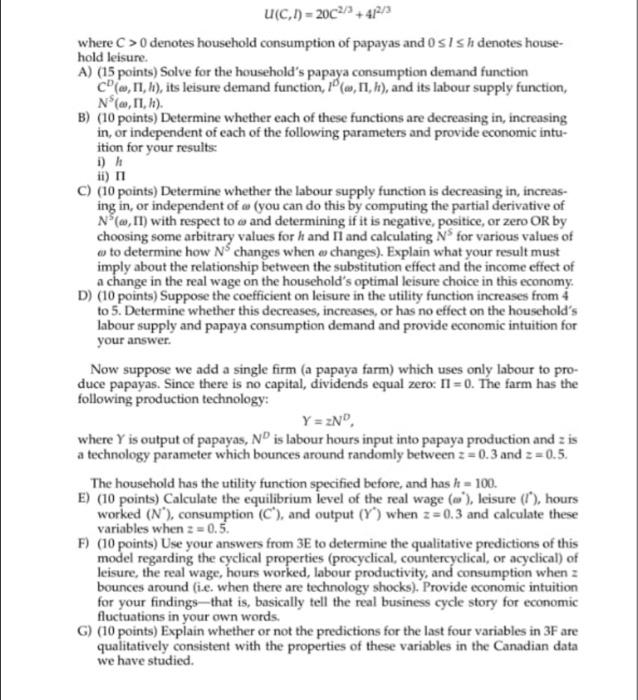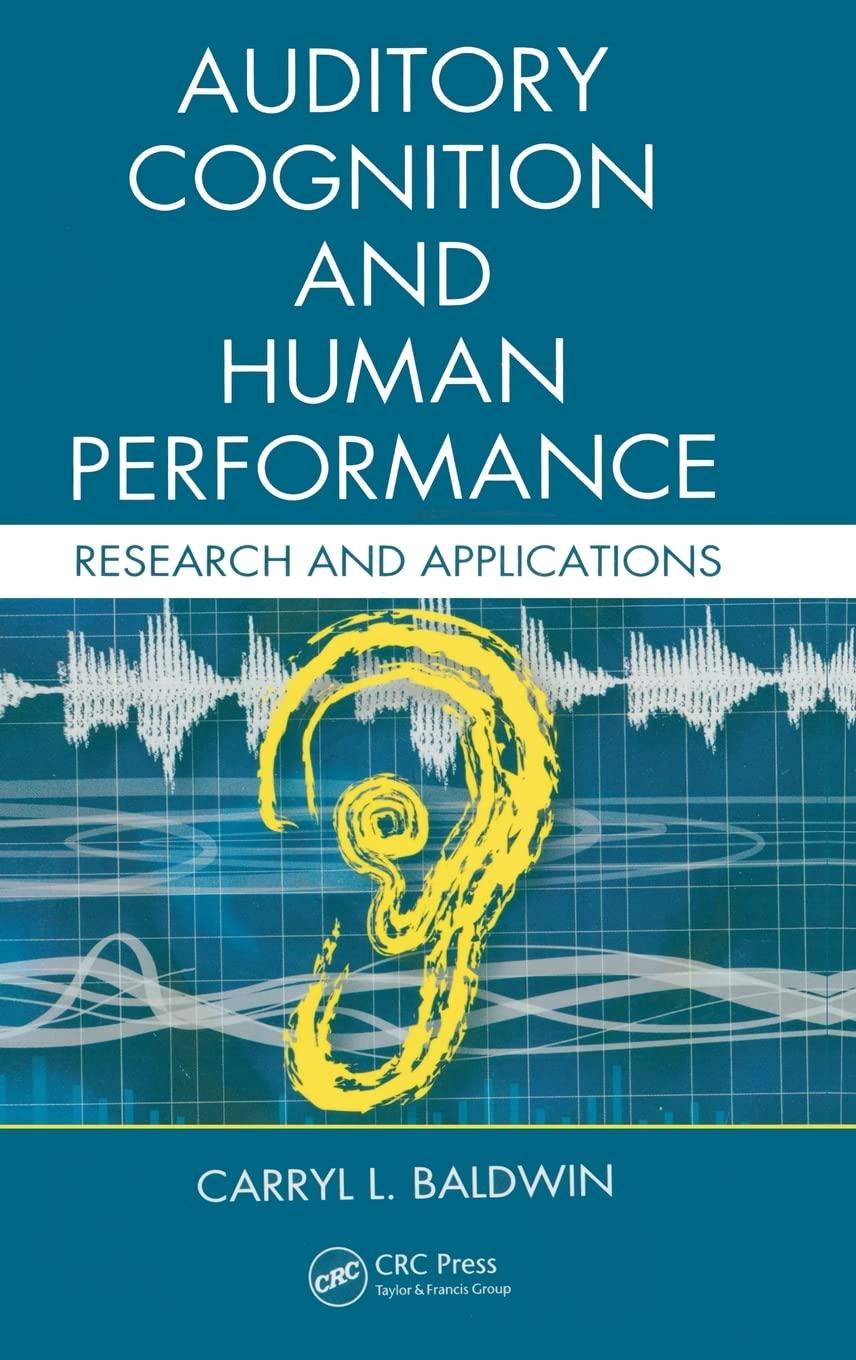PLEASE PLEASE PLEASE ANSWER PART E, what makes this incomplete, what do you need?? 

Part 2: (75 points) Suppose there is a country with one household which values consumption of a final good (papayas) and leisure. The household has h units of time which can be split between working and leisure. Treat h as an exogenous parameter. The household receives a real wage equal to for each unit of time it works. The household receives dividends from its ownership of a firm equal to . For questions 3A to 3D, treat and II as exogenous variables (because you are only solving the houshold's problem in those questions). The household's preferences over consumption of papayas and leisure are given by the following utility function: U(C,l)=20C2/3+4l2/3 where C>0 denotes household consumption of papayas and 0lh denotes household leisure. A) (15 points) Solve for the household's papaya consumption demand function CD(,II,h), its leisure demand function, lJ(,II,h), and its labour supply function, Ns(,I1,h). B) (10 points) Determine whether each of these functions are decreasing in, increasing in, or independent of each of the following parameters and provide economic intuition for your results: i) h ii) C) (10 points) Determine whether the labour supply function is decreasing in, increasing in, or independent of a (you can do this by computing the partial derivative of N5(,II) with respect to and determining if it is negative, positice, or zero OR by choosing some arbitrary values for h and II and calculating N5 for various values of to determine how N5 changes when changes). Explain what your result must imply about the relationship between the substitution effect and the income effect of a change in the real wage on the houschold's optimal leisure choice in this economy. D) (10 points) Suppose the coefficient on leisure in the utility function increases from 4 to 5. Determine whether this decreases, increases, or has no effect on the houschold's labour supply and papaya consumption demand and provide economic intuition for your answer. Now suppose we add a single firm (a papaya farm) which uses only labour to produce papayas. Since there is no capital, dividends equal zero: II=0. The farm has the following production technology: Y=zND. where Y is output of papayas, ND is labour hours input into papaya production and z is a technology parameter which bounces around randomly between z=0.3 and z=0.5. The household has the utility function specified before, and has h=100. E) (10 points) Calculate the equilibrium level of the real wage (a), leisure (l), hours worked (N), consumption (C), and output (Y) when z=0.3 and calculate these variables when z=0.5. F) (10 points) Use your answers from 3E to determine the qualitative predictions of this model regarding the cyclical properties (procyclical, countercyclical, or acyclical) of leisure, the real wage, hours worked, labour productivity, and consumption when z bounces around (i.e. when there are technology shocks). Provide economic intuition for your findings-that is, basically tell the real business cycle story for economic fluctuations in your own words. G) (10 points) Explain whether or not the predictions for the last four variables in 3F are qualitatively consistent with the properties of these variables in the Canadian data we have studied. Part 2: (75 points) Suppose there is a country with one household which values consumption of a final good (papayas) and leisure. The household has h units of time which can be split between working and leisure. Treat h as an exogenous parameter. The household receives a real wage equal to for each unit of time it works. The household receives dividends from its ownership of a firm equal to . For questions 3A to 3D, treat and II as exogenous variables (because you are only solving the houshold's problem in those questions). The household's preferences over consumption of papayas and leisure are given by the following utility function: U(C,l)=20C2/3+4l2/3 where C>0 denotes household consumption of papayas and 0lh denotes household leisure. A) (15 points) Solve for the household's papaya consumption demand function CD(,II,h), its leisure demand function, lJ(,II,h), and its labour supply function, Ns(,I1,h). B) (10 points) Determine whether each of these functions are decreasing in, increasing in, or independent of each of the following parameters and provide economic intuition for your results: i) h ii) C) (10 points) Determine whether the labour supply function is decreasing in, increasing in, or independent of a (you can do this by computing the partial derivative of N5(,II) with respect to and determining if it is negative, positice, or zero OR by choosing some arbitrary values for h and II and calculating N5 for various values of to determine how N5 changes when changes). Explain what your result must imply about the relationship between the substitution effect and the income effect of a change in the real wage on the houschold's optimal leisure choice in this economy. D) (10 points) Suppose the coefficient on leisure in the utility function increases from 4 to 5. Determine whether this decreases, increases, or has no effect on the houschold's labour supply and papaya consumption demand and provide economic intuition for your answer. Now suppose we add a single firm (a papaya farm) which uses only labour to produce papayas. Since there is no capital, dividends equal zero: II=0. The farm has the following production technology: Y=zND. where Y is output of papayas, ND is labour hours input into papaya production and z is a technology parameter which bounces around randomly between z=0.3 and z=0.5. The household has the utility function specified before, and has h=100. E) (10 points) Calculate the equilibrium level of the real wage (a), leisure (l), hours worked (N), consumption (C), and output (Y) when z=0.3 and calculate these variables when z=0.5. F) (10 points) Use your answers from 3E to determine the qualitative predictions of this model regarding the cyclical properties (procyclical, countercyclical, or acyclical) of leisure, the real wage, hours worked, labour productivity, and consumption when z bounces around (i.e. when there are technology shocks). Provide economic intuition for your findings-that is, basically tell the real business cycle story for economic fluctuations in your own words. G) (10 points) Explain whether or not the predictions for the last four variables in 3F are qualitatively consistent with the properties of these variables in the Canadian data we have studied








